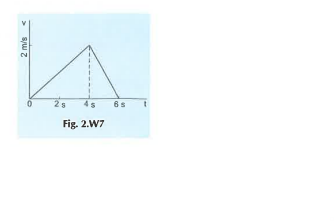Statement 1 : If the mass of the colliding particles remains constant, then the linear velocity of the individual particles change during collision along common normal direction.
Statement 2 : A pair of equal and opposite impulses act along common normal direction.
Statement-1 is True, Statement-2 is True,
Statement-2 is a correct explanation for Statement-1.
Statement-1 is True, Statement-2 is True,
Statement-2 is NOT a correct explanation for Statement-3
Statement-1 is True, Statement-2 is False
Statement-1 is False, Statement-2 is False
The correct Answer is:A
Step by step video, text & image solution for Statement 1 : If the mass of the colliding particles remains constant, then the linear velocity of the individual particles change during collision along common normal direction. Statement 2 : A pair of equal and opposite impulses act along common normal direction. by Physics experts to help you in doubts & scoring excellent marks in Class 12 exams.
Similar Questions
A particle of mass m1 moves with velocity v1 and collides with another particle at rest of equal mass. The velocity of the second particle after the elastic collision is
View SolutionStatement - 1 : If net force →F acting on a system is changing in direction only, the linear momentum (→p)of system changes in direction. Statement - 2 : In case of uniform circular motion, magnitude of linear momentum is constant but direction
View Solution
Knowledge Check
- Question 1 - Select One
Statemetn 1: The linear velocity of the individual smooth particles undergoing collision change along the common normal direction.
Statement 2: The bodies apply a pair of equal and opposite forces along their common normal.ABoth statements 1 and 2 are true and statement 2 is the correct explanation of statement 1.BBoth statements 1 and 2 are true but statement 2 is not the correct explanation of statement 1.CStatement 1 is true but staement 2 is false.DStatement 1 is false, but statement 2 is true - Question 2 - Select One
A particle is moving with constant angular velocity along the circumference of a circle. Which of the following statements is true
AThe particle so moving executes S.H.M.BThe projection of the particle on any one of the diameters executes S.H.M.CThe projection of the particle on any of the diameters executes S.H.M.DNone of the above - Question 3 - Select One
Statement-1 : A particle of mass m strikes a smooth wedge of mass M as shown in the figure. Linear momentum of particles along the inclined surface of wedge is conserved during collision.

and
Statement-2 : Wege exerts a force on particle perpendicular to inclined face of wedge during collision.AStatement -1 is True, Statement -2 si True , Statement -2 is a correct explanation for Statement -1.BStatement -1 is True, Statement -2 si True , Statement -2 is not correct explanation for Statement -1.CSatement-1 is True, Statement-2 is Satement-1 is True, Statement-2 is False.DSatement-1 is False, Statement-2 is True.
The velocity-time graph of a particle moving along a straight line is shown in Figure 2.W7.
Does the particle change its direction of motion ? View Solution
View SolutionStatement 1: A charged particle undergoes non-rectilinear motion in a constant magnetic field. The only force acting on the particle is the magnetic force. Then kinetic energy of this particle remains constant but momentum of the particle does not remains constant.
Statement 2: A force that always acts on the particle in direction perpendicular to its velocity does no work on the particle. But whenever a force acts on the particle, momentum of the particle does not remains constant.View SolutionStatement I Acceleration of a moving particle can be changed without changing direction of velocity.
Statement n If the direction of velocity changes, so the direction of acceleration also changes.View SolutionWhen a particle is moving along a circular path with uniforme speed , the physical quantity which remains constant both in magnitude and direction is
View SolutionStatement-I : If two particles, moving with constant velocities are to meet, the relative velocity must be along the line joining the two particles.
Statement-II : Relative velocity means motion of one particle as viewed from the other.View Solution

